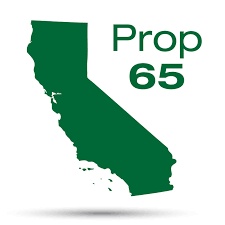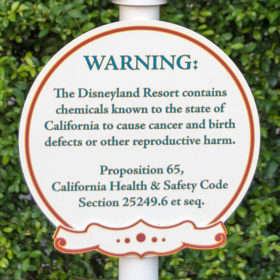
As laws change to allow health conscious consumers more knowledge about what’s in consumer products, so do the unintended consequences, such as with California’s Prop 65 warning requirements. Prop 65 started with good intentions, but as with many other things in the marketplace, has gotten turned upside down, resulting in some unexpected and unfortunate outcomes, especially for supplement manufacturers.
Does the mere presence of a Prop 65 warning on a product label mean that the product is unsafe to use? Or conversely, that a competing product lacking the warning provides better safety?
The short answers:
No, and no.
This doesn’t mean Prop 65 warnings should be ignored, nor does it necessarily mean you shouldn’t buy products with Prop 65 warnings. Instead, keep reading so that you can be an educated consumer, and make the best choices for yourself and your family.
The long answers:
The 1986 California Proposition 65 law (more commonly known as Prop 65) is a piece of legislation that’s unique to the State of California and, in theory, only applies to products sold in, and to commercial establishments within that state. Prop 65 is officially known as The Safe Drinking Water and Toxic Enforcement Act of 1986 – though most still refer to it by its original name of Prop 65, which is what is typically listed on products with labels identifying as such.
Its purpose is to not only increase public awareness about the potentially dangerous stuff you may not realize is in the products you buy, but also to prevent businesses from knowingly dumping toxic chemicals into the water supply. It all sounds great in theory so far.
Nature’s Complement is all about transparency of ingredients and safe products, and we believe that producers should have to disclose everything that is in a product. We think people have a right to know before they buy. However, with that said, Prop 65 has some flaws as implemented.
Prop 65 is a perfect example of a good idea, and a good intention, being poorly executed, and thus losing much of its usefulness in the real world. While we love the ideas of transparency, full product disclosure, and warnings about harmful ingredients, the Prop 65 limits that were set are unrealistically low. This is particularly true for naturally occurring products, like plant products. Perhaps more importantly, the lack of detailed information about which compounds are problematic in a specific product, and how they are used in a specific product, further limit the usefulness of a law.
For example, a friend of ours recently bought a new clothes washer which came with a Prop 65 warning. But the only way to determine what the chemical of concern is (or how it is used) was to call the manufacturer. I don’t know that all manufacturers would be so forthcoming, but this company was. They explained that lead was used in the internals of the motor that runs the washing machine. Now in practice almost no one will be exposed to the lead on the internals of the motor unless you are doing home repair work 10 or 20 years from now, and even then it would be unlikely that you would actually be exposed (via ingestion) to any meaningful amount of lead. Yet the manufacturer is required to list the Prop 65 warning regardless. This results in a slight fear when purchasing the product, that one or more chemicals are going to taint the clothing that will be washed in the washer. In this case the answer is “no that won’t happen”.

So while Prop 65 as originally conceptualized was a good idea, how it has actually been implemented has little practical utility, and has made the warning label almost useless, if not a parody of itself. What’s worse is it desensitizes people to the real problem of toxic chemical exposure, and discredits the idea of transparency and appropriate labeling. Yet without providing details of how a dangerous chemical is used, and what the likelihood of exposure is, it becomes impossible to do any meaningful risk assessment of that product.
This doesn’t mean Californians should get rid of the law, but rather, these problems could be fixed if the warnings actually provided sufficient detail to be useful. For example, listing the specific chemicals and how they are used, in an online database would allow those who want to know, that very knowledge. AND the law needs to be fixed so that the limits are set to realistic levels. For example, many nutritional supplement companies who sell herbs now must list a Prop 65 warning on products because the levels of compounds that naturally occur in soil and plants is above the level required by Prop 65 – even though those naturally occurring levels pose no risk to human health. Does this make sense? Of course not. But it is what it is.
Down the Rabbit Hole We Go
As of September of 2019, the Prop 65 database1 contains just over 1,000 chemicals that are believed to have health risks, such as causing cancer, birth defects, reproductive harm, etc. With such a broad array of chemicals and potential effects, a generic warning is not sufficient for the consumer to make an educated decision.
But let’s back up to the threshold limits that Prop 65 requires for labeling. Businesses are required to provide a warning if substances contain one of the over 1,000 chemicals included in the Prop 65 list.2 These “safe harbor” levels consist of No Significant Risk Levels for chemicals listed as causing cancer, and Maximum Allowable Dose Levels for chemicals listed as causing birth defects or other reproductive harm.3 The issue here is what level is considered a risk. The Prop 65 requirements apply to amounts above what would present a 1-in-100,000 risk of cancer, assuming lifetime exposure for carcinogens, or above one-one-thousandth (1/1000) of the no observable adverse effect level for reproductive toxins.4
The Office of Environmental Health Hazard Assessment (OEHHA pronounced oh-EEE-ha), is the specialized department within the cabinet-level California Environmental Protection Agency (CalEPA) with the responsibility for evaluating health risks from environmental chemical contaminants. Prop 65 is considered one of it’s traditional roles. When it comes to the chemicals that are on the 65 list, this is the statement from their website:
“The list contains a wide range of naturally occurring and synthetic chemicals that include additives or ingredients in pesticides, common household products, food, drugs, dyes, or solvents. Listed chemicals may also be used in manufacturing and construction, or they may be byproducts of chemical processes, such as motor vehicle exhaust.“5
There is an additional problem that many of the chemicals on the list are completely man-made, while others occur naturally and are often found in soil or water without any human involvement. Such naturally occurring compounds can thus be found in plants that grew in that soil/water, or even animals that lived on that soil and drank that water. But there’s no difference in the warning label. How is a consumer to know what chemical is a risk, if it’s man made or natural? Or how it got in the final product in the first place? These issues need to be addressed.
So, what does all this have to do with supplements?
It’s very easy to go down this rabbit hole and forget what the point of this was, but the question being asked is if you should be concerned in purchasing supplements that have the prop 65 warning label.
In November of 2014, a letter was written to OEHHA during their public comment period in regards to potential regulatory action. In that letter it was pointed out how the strict standards in safe levels are not comparable to other determined safe standards of the U.S. FDA, EPA, Institute of Medicine, and World Health Organization. Those agencies have done extensive research on the health impact and toxicity of common chemicals. More importantly, the letter pointed out, “It is also unclear how natural product manufacturers can be expected to routinely test for all of the over 1,000 different chemicals on the Prop 65 list. Because of the expense in testing for each of the chemicals on the list, it is cheaper for firms to use a generic warning statement despite being below the allowable level.”6
What’s worse, Prop 65 initially became law in 1987. That’s over 30 years ago. We certainly didn’t have the resources than that we do now, so an update of the law is way overdue. Currently, chemicals are added and removed from the Prop 65 list, but that’s not the type of update I’m referring to. What I’m referring to is updating the requirements for disclosure. The latest update I could find was implemented in August of 2018, after being devised in 2016. There were some very positive changes which were greatly needed, but unfortunately, we’re still kind of stuck in the same place as we were before.
For instance, the regulations now require that a business has to list at least one chemical that results in the Prop 65 warning. But if the product contains, let’s say five known chemicals that are toxic, only one has to be listed. So if the business decides to list the one they deem least toxic, the consumer may buy the product not realizing that there are other chemicals still not listed. (Why only one chemical needs to be listed is beyond me, since it doesn’t really make any sense.)
Even more confusing is what different labels actually mean, and when they are applicable. Technically, there are specific labeling requirements that business are supposed to follow. But how is a business to know if their products contain certain chemicals, if let’s say they are re-selling a product? The warning regulations do not address the question of whether a warning is required; rather, the regulations provide guidance on how to provide a warning once a business has made a determination that a warning is required. And OEHHA’s regulations do not require a business to perform any testing.7
Also, businesses are not required to provide a warning if a product causes exposure to a chemical at or below the Prop 65 levels. (Although this is an unlikely scenario since the limits have been set unrealistically low to begin with.)
It’s also important to point out that any business that produced a product prior to the last change in these requirements, does not have to re-label with the new label as long as they were compliant with the old laws. As you can see, this can get complicated and confusing rather quickly.
This confusion often leads businesses to simply use and maintain generic Prop 65 warnings – just in case their products contain any listed chemicals. Meaning their products may not contain any of the Prop 65 chemicals, or could contain all 1,000+ of them. Fortunately, this practice was deprecated by the 2016 rules change.8 Regardless, many businesses still do this, either due to a lack of awareness of the change, or due to inertia of convenience.
No Prop 65 Warning = Safe?
Just because a product does not have a Prop 65 warning does not necessarily mean that the product is free from those hazards. The product may not have been tested for all of the potential hazards, the business might not be aware if they were not informed properly, and the law only prohibits “businesses from knowingly exposing individuals to listed substances without providing a clear and reasonable warning.” Or to state it simply, if the business doesn’t know, they don’t have to warn. Also, businesses with 10 employees or less are exempt from warning labels… So there are quite a few loop holes in the law.
Bottom Line
So what does all this mean in practice? The bottom line is there are a large number of products, including supplements, that are labeled (either by the old standards, or the new ones), such that no one can make heads or tails out of what the labels really mean, because there are so many inconsistencies. Either the statements don’t need to be present but are, or should be present but are not – due to legal loop holes. In short, it is a mess that is too complex for most people to make use of. Of course, the lawmakers get it, but they eat, breathe and excrete these regulations, so it’s easy for them to understand. But the everyday business owner? And the everyday consumer? Well researched scientist? Not so much.
Until these problems are corrected, Prop 65 warnings are not particularly useful for safety or risk assessment. As a former toxicology researcher, I have no idea how to apply this mere warning label to any toxicology assessment without additional information.

By Patrick Pelletier – Own work, CC BY-SA 4.0, Link
Key Points:
- Prop 65 is the perfect example of legislation that started out as a theoretically good idea with good intentions, but has ended up being far from ideal in real world practice due to the details of how it was implemented.
- Prop 65 warnings can be found on the packaging of almost any product you buy, from food and supplements to clothes and gardening shovels.
- Prop 65 chemicals and their respective “safe use” thresholds are only recognized in California, not by any other federal or international regulatory body. The FDA has criticized and overruled Prop 65 in some cases. In many cases the levels set by Prop 65 are unrealistically (impossibly) low.
- Prop 65 warnings do not tell you how a particular compound got into a product, nor if it was added or naturally occurring.
- Prop 65 warnings do not tell you how a particular chemical was used in a product, and therefore do not provide sufficient information to make any kind of useful or realistic risk assessment about a product.
- Prop 65 does not require all chemicals be listed. If a product has 5, only 1 has to be listed.
- A Prop 65 warning on a product label doesn’t necessarily mean the product is unsafe, or that you shouldn’t use it. That’s why it’s only a “warning” label.
- You may see a warning label on a product that in reality contains safe levels (or none) of a substance. Many companies protect themselves from legal liability by putting a label on their products, even if it may not be necessary.
- Many products do not have a warning label when they should, because the business is not aware that the product contains chemicals on the Prop 65 list.
- Warnings are not all about man-made chemicals or petroleum by-products in question; often they’re about something naturally occurring in plants (like trace metals).
- Science regarding cancer probabilities is complicated and usually isn’t black and white.
- The debate about Prop 65 is ongoing, and could eventually change substantially from where it is now.
Deciphering confusing laws and how businesses most economically apply them is not easy, but this is an important topic to cover. We are seeing an increasing number of products springing up carrying Prop 65 warning labels (which may or may not actually mean anything), so we felt it appropriate to clarify what the label really means.
For Health,
Rob
References Cited:
1 “Proposition 65 List.” OEHHA. California Office of Environmental Health Hazard Assessment, Web. 16 Feb 2020. <http://oehha.ca.gov/proposition-65/proposition-65-list>.
2Wikipedia. “California Office of Environmental Health Hazard Assessment.” 28 Oct 2019. Web. 16 Feb 2020. <https://en.wikipedia.org/wiki/California_Office_of_Environmental_Health_Hazard_Assessment>
3“Propositon 65 Clear and Reasonable Warnings; Questions and Answers for Businesses.” Office of Environmental Health Hazard Assessment California Environmental Protection Agency. May 2019. Web. 16 Feb 2020. <https://www.p65warnings.ca.gov/sites/default/files/art_6_business_qa.pdf>.
4“Proposition 65 in Plain Language.” California Office of Enviornment Health Hazard Assessment. OEHHA, 01 Feb 2013. Web. 16 Feb 2020. <https://oehha.ca.gov/proposition-65/general-info/proposition-65-plain-language>.
5“About Proposition 65 .” California Office of Environmental Health Hazard Assessment. OEHHA, Web. 16 Feb 2020. <https://oehha.ca.gov/proposition-65/about-proposition-65>.
6Natural Products Association. “Open letter to OEHHA from the Natural Products Association.” OEHHA, 17 Nov 2014. Web. 16 Feb 2020. <https://oehha.ca.gov/media/downloads/proposition-65/crnr/comments/nov14natprodassoc.pdf>.
7“Propositon 65 Clear and Reasonable Warnings; Questions and Answers for Businesses.” Office of Environmental Health Hazard Assessment California Environmental Protection Agency. May 2019. Web. 16 Feb 2020. <https://www.p65warnings.ca.gov/sites/default/files/art_6_business_qa.pdf>.
8“Proposed Repeal of Article 6 and Adoption of New Article 6 Regulations for Clear and Reasonable Warnings .” Article 6 Clear and Reasonable WarningsFinal Statement of ReasonsOffice of Environmental Health Hazard Assessment Page 1 of 273Title 27, California Code of Regulations, Article 6Clear and Reasonable WarningsFinal Statement of ReasonsTitle 27, California Code of Regulations. California Environmental Protection AgencyOffice of Environmental Health Hazard Assessment, 25 Mar 2016. Web. 16 Feb 2020. <https://oehha.ca.gov/media/downloads/crnr/art6fsor090116.pdf>.
Nature's Complement is a participant in the Amazon Services LLC Associates Program, an affiliate advertising program. If you purchase products on Amazon through any of our affiliate links, we get a small percentage of the transaction, at no extra cost to you. We spend a lot of time writing the articles on this site, and all this information is provided free of charge. When you use our affiliate links, you support the writing you enjoy without necessarily buying our products. (However we would appreciate if you would do that too!) Thank you for helping to support our work, however you choose to do so.
These statements have not been evaluated by the Food and Drug Administration. This information and/or products are not intended to diagnose, treat, cure or prevent any disease.


